Red eye tetras are beautiful and charming fish to have in a tank, but they’re even better with more friends to swim with! The question is, which fish make the best tank mates for red eye tetras?
The best red eye tetra tank mates are fish that are similar in size and temperament to the red eye tetra. That said, it is very important that the tank mates not have a diet that is too similar to avoid competition. Some of the best tank mates for red eye tetras are other tetras or peaceful, small fish like molly or danio.
In this article we’ll cover the best red eye tetra tank mates. This helpful information will include what a fish owner needs to know, not just about their tetra, but about potential tank mates, as well as what makes our list of companion options special. Let’s get started!
Contents
Red Eye Tetra Tank Mates – What You Need to Know
You’ll find everything that is important to know about the red eye tetra and it’s tank mates in the short summaries below.
Temperament
The red eye tetra is known for it’s peaceful temperament, but peaceful does not always mean boring! The red eye tetra is used to having friends it can play with. It enjoys the company of its own kind and sometimes other peaceful fish as well.
Red eye tetras should not be kept with aggressive fish, or even territorial fish, if at all possible. A difference in temperament this extreme can lead to a stressed tetra at best, and a dead tetra at worst.
Size
The red eye tetra’s size is important to know because a fish that is too much smaller than a red eye tetra will be in danger of being stressed by the larger fish’s movements. A fish that is bigger than the red eye tetra, on the other hand, can start mistaking your red eye tetra for it’s next meal!
To avoid these unpleasant scenarios, get fish that are not much different in size than the red eye tetra’s 2 to 3 inch length.
Competition
Red eye tetras love to eat! They typically eat an omnivorous diet, which includes pellet and flake foods, frozen or freeze-dried food, spirulina, live food, bloodworms, and brine shrimp. They tend to eat more than once a day and eat quickly.
For tank mates, the diet should be varied from the red eye tetras in order to cut down on competition.
Parameters & Tank Setup
The red eye tetra needs a group of at least 6 of it’s own kind, and in a community tank, it should have at least 20 gallons of space. You can keep the temperature range between 72 and 79 degrees Fahrenheit, and make sure the aquarium is dimly lit with plenty of plants throughout the space. Fish that like these same conditions make great red eye tetra tank mates!
Best Red Eye Tetra Tank Mates
- Black Neon Tetra
- Rummy Nose Tetra
- Serpae Tetra
- Harlequin Rasbora
- Black Skirt Tetra
- Apple Snail
- Golden Pencil Fish
- Giant Danio
- Zebra Danio
- Botia Loach
Let’s look at each of our potential red eye tetra tank mates in more detail!
Check out these other popular posts in this category:
1. Black Neon Tetra

- Scientific Name: Hyphessobrycon herbertaxelrodi
- Adult Size: 1.5 inches
- Compatible With: Red Eye Tetras
- Care Level: Easy
- Origin: Brazil
Black Neon tetras are a fantastic choice for red eye tetra tank mates. They are just as energetic in temperament as red eye tetras, playing and swimming joyfully with tank mates that are not too intimidating.
These fish are named for their neon coloring, which is actually offset by a stripe of black. This same black coloring tinges some of their fins, too.
Pros of keeping with Red Eye Tetra:
- No aggression
- No food competition
Cons of keeping with Red Eye Tetra :
- None
2. Rummy Nose Tetra
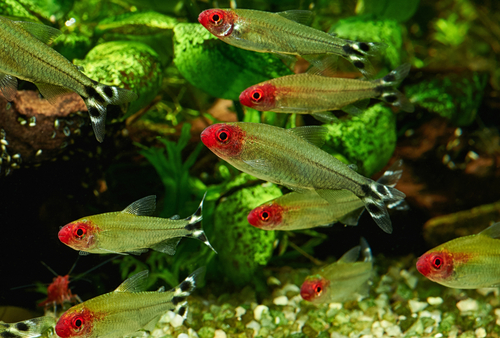
- Scientific Name: Hemigrammus rhodostomus
- Adult Size: 2 inches
- Compatible With: Red Eye Tetras
- Care Level: Easy
- Origin: South America
The Rummy Nose Tetra is another great choice for tank mates when it comes to red eye tetras. They not only enjoy the same water parameters as their brethren, the red eye tetra, but they are also very similar in playful and peaceful temperament.
Rummy nose tetras are typically silver and named for their red nose/face area. This is paired with snappy white and black stripes on their tail fins.
Pros of keeping with Red Eye Tetra:
- No aggression
- No food competition
Cons of keeping with Red Eye Tetra :
- None
3. Serpae Tetra
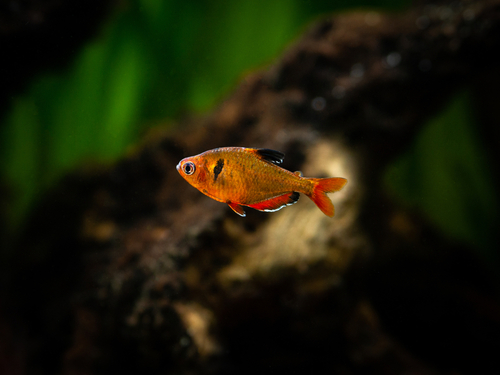
- Scientific Name: Hyphessobrycon eques
- Adult Size: 1 inch
- Compatible With: Red Eye Tetras
- Care Level: Easy
- Origin: Brazil, Paraguay, Argentina, Peru
The serpae tetra can live for up to 7 years, and these years are filled with it’s fun-loving antics with friends! Serpae tetras, like red eye tetras, are energetic but peaceful, enjoying schools of their own kind.
The serpae tetra is reddish gold with black fins. It is sometimes referred as the jewel tetra because of its beautiful coloration.
Pros of keeping with Red Eye Tetra:
- No food competition
- No aggression
Cons of keeping with Red Eye Tetra :
- None
4. Harlequin Rasbora
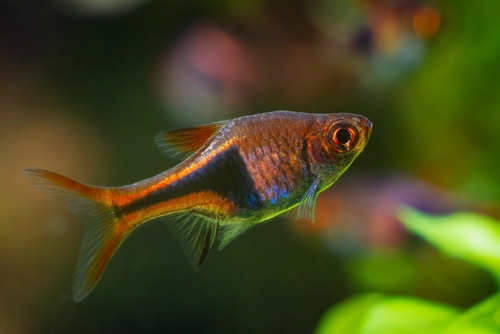
- Scientific Name: Trigonostigma heteromorpha
- Adult Size: 1 inch
- Compatible With: Red Eye Tetras
- Care Level: Medium Difficulty
- Origin: Southeast Asia, Singapore, Malaysia, Thailand, Sumatra
The harlequin rasbora is a fish that swims along the top and middle of the tank, enjoying it’s tank mates as long as they are peaceful in temperament. It tends to eat an omnivorous diet, but does not feed as frequently as a red eye tetra, making it a great tank mate.
The harlequin rasbora is a sporty-looking fish with an arrowhead-shaped body, a silver-white belly capped with yellow-gold, and a fierce-looking black triangle along it’s tail.
Pros of keeping with Red Eye Tetra:
- Little food competition
- No aggression
Cons of keeping with Red Eye Tetra :
- None
5. Black Skirt Tetra

- Scientific Name: Gymnocorymbus ternetzi
- Adult Size: 2 inches
- Compatible With: Red Eye Tetras
- Care Level: Easy
- Origin: Rio Guapore, Rio Paraguay, Bolivia
The black skirt tetra goes by a few other names, such as the black tetra or simply the black skirt fish. It only gets up to two inches long in length, and is generally a muddy, dark gray to black color all over.
Black skirt tetras are more round than their cousin the red eye tetra in shape, and their mild-looking faces are usually framed by slightly darker coloration. They tend to swim in the middle of the tank, and enjoy being around 6 or more tetras of their own species. Black skirt tetras are one of the hardiest types of tetra I’ve ever kept which makes them a great fit for new and experienced aquarists alike!
Pros of keeping with Red Eye Tetra:
- No aggression
- No food competition
Cons of keeping with Red Eye Tetra :
- None
6. Apple Snail
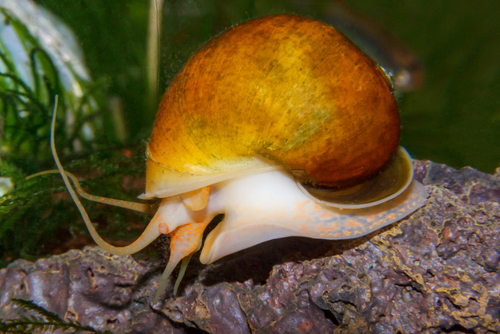
- Scientific Name: Ampullariidae
- Adult Size: 3 inches
- Compatible With: Red Eye Tetras
- Care Level: Easy
- Origin: South America
Apple snails, otherwise known as golden apple snails, are a great change of pace from the other fish on our list as a tank mate for the red eye tetra. They pose no threat of aggression to any fish, and they are a pleasing piece of visual variety in a community tank!
Apple snails are not just golden or yellow in shell color. They can be white, brown, yellow, tan, and even more exotic colors ranging from green to pink to blue. They can also come with bands of color along their shells, or plain, and they like to scavenge along the bottom of the tank.
Pros of keeping with Red Eye Tetra:
- Too big to be eaten
- No aggression
- Cleans up Tank
- No Food competition
Cons of keeping with Red Eye Tetra :
- None
7. Golden Pencilfish

- Scientific Name: Nannostomus beckfordi
- Adult Size: 3 inches
- Compatible With: Red Eye Tetras
- Care Level: Easy
- Origin: Brazil, Suriname, Venezuela, Guyana
Golden pencilfish are some of the most fascinating fish to hit the aquarium community. They are long, lean, and beautiful in appearance. A golden pencilfish is named for it’s mottled coloration, which is usually sunny in color, like the inside of an orange or grapefruit. This is striped strikingly with black, and capped by translucent fins.
Golden pencilfish are more peaceful members of an aquarium, preferring to keep to their own space. They will pose no threat of violence or even food competition to your red eye tetra.
Pros of keeping with Red Eye Tetra:
- No aggression
- No food competition
Cons of keeping with Red Eye Tetra :
- None
8. Giant Danio
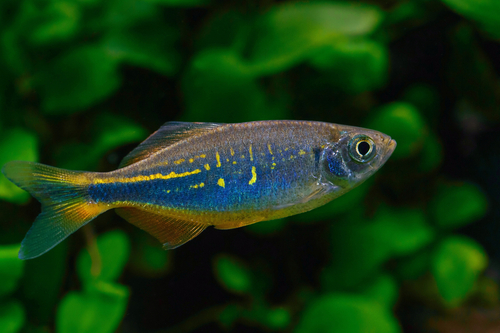
- Scientific Name: Devario aequipinnatus
- Adult Size: 4 inches
- Compatible With: Red Eye Tetras
- Care Level: Easy
- Origin: Nepal, India, Myanmar, Bangladesh, Thailand
Giant danios may seem like a surprising addition to this list; after all, they are they can grow to almost twice the size of a red eye tetra, and their big size is what earns them their name. Giant danios are certainly a bit thicker than their smaller danio relatives, and they have more bold coloring patterns.
Despite the size difference, giant danios are no threat to red eye tetras! They are generally a bit slower-moving, but not aggressive or territorial. Giant danios are typically a shade of aqua capped by darker iridescence with yellow markings and silver faces.
Pros of keeping with Red Eye Tetra:
- No aggression
- No food competition
Cons of keeping with Red Eye Tetra :
- None
9. Zebra Danio
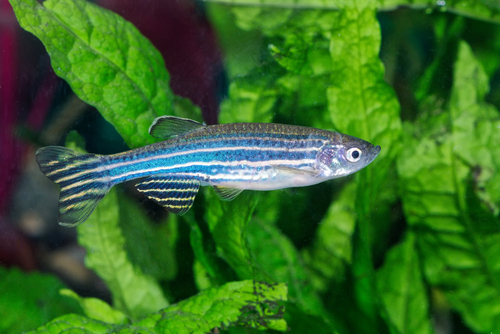
- Scientific Name: Danio rerio
- Adult Size: 2 inches
- Compatible With: Red Eye Tetras
- Care Level: Easy
- Origin: Eastern India
Zebra danios are some of the most popular aquarium fish in the fish community. They generally get along well with many different kinds of fish as long as those fish are not overly large or aggressive.
Zebra danios have the funny look of a startled fish with gray-blue faces and light yellowish silver eyes. They have dark stripes like their name suggests with warmer peach and yellow colors.
Pros of keeping with Red Eye Tetra:
- No aggression
- No food competition
Cons of keeping with Red Eye Tetra :
- None
10. Botia Loach

- Scientific Name: Botia Dario
- Adult Size: 5 inches
- Compatible With: Red Eye Tetras
- Care Level: Easy
- Origin: Bangladesh, India
Botia loaches are semi-aggressive, but with plenty of plants to break up their line of sight, they should pose no problem to your red eye tetra tank mates.
They are striped as well, preferring to dwell near the bottom of the tank. They are yellow and black in color, with funny little whiskers at the end of their sloped faces.
Pros of keeping with Red Eye Tetra:
- Little aggression with eyeline breakups
- Cleans up the bottom of the tank
- No food competition
Cons of keeping with Red Eye Tetra :
- None
Maintaining a Healthy Environment for Red Eye Tetra and Their Tank Mates

Creating and maintaining a healthy tank environment is vital for your red eye tetras and their companions. Here’s a guide to ensure your aquarium remains a thriving habitat for these elegant fish.
Cleaning and Decorating the Aquarium
Efficient cleaning and thoughtful decorating are crucial for a healthy aquarium. Begin by rinsing the decorations with warm water to remove dirt or algae.
While cleaning the aquarium’s glass, use a soft cloth or sponge, and avoid harsh chemicals that could harm your red eye tetra and lamp eye tetra tank mates. A well-decorated tank with ample hiding spots and swimming areas is not only visually appealing but also promotes the well-being of your fish.
Consistent Water Changes
Regular water changes are essential in maintaining optimal water quality. For red eye tetra and lamp eye tetra tank mates, replace 25-30% of the tank water every two weeks. This routine helps maintain a balanced pH level between 6.5 and 7.5 and removes excess waste, ensuring a healthy environment for your fish.
Effective Filter Maintenance
A high-quality filter is key to keeping the tank water clean and ensuring adequate circulation. However, ensure the filter’s flow isn’t too strong, as excessive water movement can stress your red eye tetra and their tank mates.
It’s also important not to over-clean the filter to preserve the beneficial bacteria essential for a healthy aquarium ecosystem.
FAQs: Red Eye Tetra and Tank Mates
What is the ideal tank size for red eye tetra tank mates?
A 20 to 30-gallon tank is recommended for housing red eye tetras with their tank mates comfortably.
Are there any incompatible species with red eye tetras?
Yes, it’s best to avoid aggressive species like Oscars, Red Tail Sharks, and Arowanas, as they can stress or eat the peaceful red eye tetras.
How can I identify compatible tank mates for red eye tetras?
Researching the behavioral traits and environmental needs of potential tank mates is crucial to ensure compatibility with red eye tetras.
How many tank mates can I keep with red eye tetras?
A group of five to six tank mates works well with red eye tetras, as they enjoy social interaction and schooling.
What is the preferred diet of red eye tetras?
Red eye tetras are omnivorous and thrive on a varied diet including flakes, pellets, and live or frozen foods such as brine shrimp and daphnia.
In Conclusion
To sum it all up, the best red eye tetra tank mates are fish that are similar to the nearly 3-inch long tetras in size, eat a varied diet to avoid competition, and share the tetra’s peaceful personality. These include other tetras, but also danios, mollies, and even some plecos! With fish like these you’ll have a happy and healthy community tank.

Ian Sterling, founder of Fishlab.com, began his aquarium journey over 30 years ago, driven by a deep fascination for fish and their diverse personalities. His website, Fishlab.com, is dedicated to making fishkeeping accessible and enjoyable, offering beginner-friendly guidance, expert insights, and a community for aquarists to connect and share experiences.


